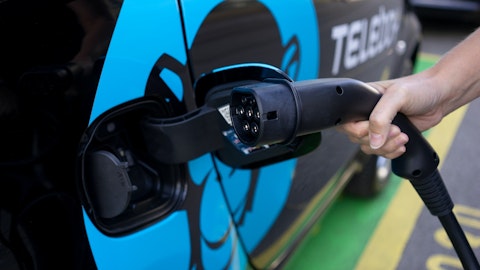Mark Smith: Right. So the good news is they’ve been performing really well. So that’s the underlying, and I think that’s — we expect that to be a continuing trend. As I mentioned earlier, typically, we see, particularly with the industrial side of that business that the customers really dropped down the purchase of parts in the fourth quarter. That’s not new, but that that typically happens every Q4, and that’s probably the main factor there — the main negative factor. Otherwise, the underlying demand is strong. There’s no major changes to pricing or the cost structure.
Tami Zakaria: Got it. That’s very helpful. And the next question is R&D spend. The R&D spend over the last five years have stepped up notably. How should we think about that spend, let’s say, in the next couple of years, and any color on that?
Jennifer Rumsey: Yes, Tami, as you noted in a period of increased R&D investment that we think will position Cummins well for the future. So in particular, now through the 2026, 2027 time frame when we launch these new fuel-agnostic engine platforms, we’re making a major R&D and capital investments, and those are bringing new customer business to us and also will position us to have leading products through the energy transition. We’ve also been increasing our investment in the Accelera business as we ramp up the product investments for our electrolyzers and see growing demand for electrolyzer volume as well as in the electrified components. So that’s really what you’re seeing come through in the R&D line. And then we’re continuing to really focus on improving underlying performance and efficiency in other areas so that we can continue to make the necessary R&D investments.
A – Mark Smith : Yes. And that’s why we’ve had a big push on the SG&A and continue to do that. So well, on gross margin. So we can grow margins, grow investment, grow the bottom line and keep improving the cash. That’s a simple formula that we’re working to. We’d like to see the cash flow come up. The engineering is going to remain these higher levels for a little while yet. And it’s also the new engine business platforms are contributing to the — yes, CapEx being higher in dollar terms. It’s in our expected range as a percent of sales. But for the next couple of years, we’ve got these renewal of these major platforms, which is important for our future.
Operator: Thank you. Our next question is from Tim Thein with Citi. Please proceed with your question.
Tim Thein: Thanks. Good morning. The first question is on Power Systems. And I’m just curious about kind of the visibility that you have looking into 2024. And backlog isn’t something that we historically really talked about with Cummins, but just given the long lead times for large engines and just visibility you have from a rebuild perspective, can you just maybe speak to where you think you exit the year in terms of — again, I know you’re not giving 2024 guidance, but just any sort of help you can give in terms of what kind of revenue visibility you would expect to exit the year with in that business?
A – Mark Smith: Yes, you’re right, Tim, that there is more visibility, but long lead times and the underlying demand. Certainly, I think we’ve got great visibility through the first half of the year. And of course, we’re seeing — we’re anticipating more pressure on the on-highway side just because not a severe downturn, but generally, market participants are expecting some moderation in heavy-duty truck orders going into next year. So we would expect more revenue headwinds on the engines and components side. Distribution, as you know, is very heavily aftermarket-driven. So absent some massive crush in the economy, that should be more stable. And then Power Systems, certainly, very strong visibility through the first half of the year and some into the second half of the year. We haven’t seen a dramatic shift in trajectory at this point in time.
Jennifer Rumsey : Yes. I mean we’re continuing to, as Mark said, to watch the Power Systems markets and in the industrial markets, we have seen a little bit of softening in oil and gas, which is a relatively small market for us that’s kind of its inverse. And so that has softened a little bit. And then in Power Gen, you see a lot of growth this year. And I expect continued strong demand in the data center market for our business, and we’re well positioned there.
A – Mark Smith: And it’s encouraging that both Power Systems and distribution now are on multi-period margin expansion trends that serve us well going forward.
Tim Thein: Yes. Okay. And then just a lot of discussion here in terms of the on-highway parts business for you. And again, I know it’s probably a bit of apples and oranges, but just listening to the commentary from your largest customer and kind of the outlook there they have for their own parts business. What do you think — again, I know you don’t want to speak for them, but what do you think is the — you mentioned down 18%, I think from the beginning of the year. I think they’re down like 2% or 3%. What do you think is driving that invariability between you come in to experience versus at least some of the OEMs? And yes, I know that the businesses don’t align perfectly, but presumably, their impacted by a lot of the same dynamics. Just curious how beyond that.
A – Mark Smith: Generally, I think it’s destocking, right? We’ve had — we have — there’s obviously, we know returns levels and things like that from all parts of our channel have gone up as customers have been deep.
Jennifer Rumsey: Yes. I think it’s really important to note through this cycle, two very different dynamics because of the supply constraints than what you would previously see. So the aftermarket demand was really strong. And with the supply constraints, it was challenging for some of our customers to get parts. And so there was a lot of focus on building up inventory to try to buffer against those constraints and a focus, frankly, on addressing the gaps that resulted in an overbuild of inventory. So now that some of those supply challenges have eased this getting inventory back to appropriate levels has been a focus, and that’s driven a drop-off beyond just the actual aftermarket demand in service. And then the same is true and happening on the first-fit build that we’ve had supply constraints that have limited our ability to meet industry demand and you see that resulting in the markets holding up longer than you would typically see and continue to see solid demand for first-fit trucks.
A – Mark Smith: And then if I just step back from the noise in this kind of correction period, Tim, clearly, our market share in North America on-highway markets has gone up noticeably so that should all go well for the parts that will inevitably be purchased through Cummins. I just think just in this correction period. I was just trying to provide that extra color this time to explain what I think a short-term margin influences, but not long-term market trends.
Operator: Thank you. Our next question is from Steven Fisher with UBS. Please proceed with your question.
Steven Fisher: Thanks. Good morning. Just curious about how much visibility you have to on-highway engine pricing going forward at this point into 2024. I guess to what extent is your pricing going to be dependent on the pricing of your OEM customers or how independent can that be?
Jennifer Rumsey: Yes, we were price cost favorable this year, as we’ve shared previously, and we have — we’re continuing to focus on pricing with new product launches and where we’ve seen inflationary costs coming through. So we’re working to continue to maintain that positive price/cost ratio. And we’re seeing some slowing of course, in pricing in the market, but we’ll expect to continue to have some of that.



